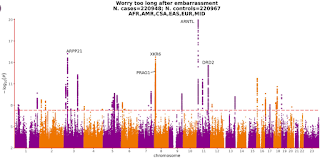The latest ADHD GWAS is available in pre-print:
Genome-wide analyses of ADHD identify 27 risk loci, refine the genetic architecture and implicate several cognitive domains
It is now formulaic to perform a GWAS "meta-analysis," rather than independently examining a new dataset. I put meta-analysis in quotes, because this is not really even what we have, since this new data which makes up half the data in the study has not been in a previous study. As I have noted repeatedly, this is problematic and I will touch on why in this critique. Let's get to the claims.
The meta-analysis identified 32 lead variants (r2 < 0.1) located in 27 genome-wide
significant loci (Figure 1; Table 1, locus plots in Supplementary Data 1), including 21 novel
loci. No statistically significant heterogeneity was observed between cohorts
The first question you might ask is why these 21 novel loci were not noted in the previous GWAS for ADHD? The argument is that when you increase the number of cases, working with a higher N, you are more likely to pick up smaller correlations. The problem with that argument can be seen by the fact that there were 12 loci found significant previously and now only 6 of them are still significant. If we were talking about two entirely different studies, where the larger one picked up 6 out of 12 loci from the previous study, you might make some claims of a modest success and the authors seem to imply exactly this:
Six of the previously identified 12 loci in the ADHD2019 study14 were significant in the present
study (Table 1), and the remaining six loci demonstrated P-values < 8x10-4
The problem here is that the data from the ADHD2919 study referenced above WAS INCLUDED IN THE CURRENT STUDY. It makes up about half the data, in fact. Thus we are not talking about independent replication, which apparently was not even attempted (or at least no such results were included). If you make the argument that increasing the case numbers identifies more significant loci, then why wouldn't you expect the previous 12 loci to be confirmed? Without even considering population stratification issues, if you have 12 loci with low p values for correlation, you are bolstering the dataset. The fact that half the loci did not retain significance should sound alarm bells.
Similarly, it is assumed that increasing case size would increase the identified h2 heritability related to genes. Let's see how that turns out:
The SNP heritability (h2
SNP) was estimated to 0.14 (s.e. =
0.01), which is lower than the previously reported h2
SNP of 0.2214. The h2
SNP for iPSYCH (h2
SNP
= 0.23; s.e. = 0.01) was in line with the previous finding, but lower h2
SNP was observed for
PGC (h2
SNP = 0.12; s.e. = 0.03) and deCODE (h2
SNP = 0.081; s.e. = 0.014). Between-cohort
heterogeneity in h2
SNP is not unusual and has been observed for other disorders like e.g. MDD <Major Depressive Disorder>.
One interpretation of this finding, apparently not occurring to the authors, is that the positive findings they have are little more than population stratification, and even in relatively homogenous (white European) cohorts, such pop strat loses its strength from one study to the next. It is a bit amusing that the counter to this is that it was observed in MDD, circularly assuming that both are valid. In other words, getting contradictory results for other diagnoses validates that it should be expected for ADHD. They, in fact, double down on this dubious argument:
The observation that previously identified
loci may not reach genome-wide significance in a subsequent larger GWAS, has also been seen
for other psychiatric disorders, e.g. bipolar disorder, where eight out of 19 loci were significant
in a subsequent larger study.
It's hard not to laugh, and I'll point out that the "larger" GWAS for other disorders like bipolar disorder also had this contradiction even though they were also using data from the studies that first "discovered" the loci.
Much of the rest of the study involved "enrichment," statistics, making the argument that cognitive related genes are more common among the significant loci. This is impossible to critique without access to the methods used. However, I would ask the authors to consider whether the 6 loci that did not remain significant were claimed to be enriched in previous studies? Is this an indication for the loci being valid, or is this an indication that these enrichment statistics are misguided?



